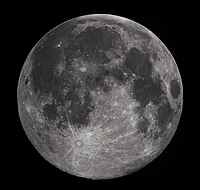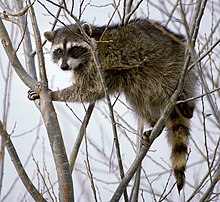
Hi Everybody!!
The Full Moon of May is known as the "Flower Moon". I went out and took pics of the moon at different times over 24 hours. I am happy to report that during the time of my observation, not once did the moon leave the sky! While I was outside looking at the moon, I saw Rocky Raccoon coming over for his daily bread. I have shared info below from Wikipedia about full moons and racoons. Your photostudy tonight is of the Flower Moon and my Rocky Raccoon, also linked to G+Album. Enjoy!



Link to my G+Albums:
https://plus.google.com/u/0/photos/117645114459863049265/albums/6013845180926110785


https://en.wikipedia.org/wiki/Full_moon
Full moon
From Wikipedia, the free encyclopedia
A full moon is the lunar phase that occurs when the moon is completely illuminated as seen from the earth. This occurs when the moon is in opposition with the sun (when it is on the opposite side of the Earth from the Sun; more precisely, when the ecliptic longitudes of the Sun and Moon differ by 180 degrees).[1] This means that the hemisphere of the Moon that is facing the Earth (the near side) is almost fully illuminated by the Sun and appears round (while the far side is almost completely unilluminated).
Lunar eclipses can occur only at full moon, where the moon's orbit allows it to pass through the Earth's shadow. Lunar eclipses do not occur every month because the moon usually passes above or below the Earth's shadow (which is mostly restricted to the ecliptic plane). Lunar eclipses can occur only when the full moon occurs near the two nodes of the orbit, either the ascending or descending node. This causes eclipses to only occur about every 6 months, and often 2 weeks before or after a solar eclipse atnew moon at the opposite node.
The time interval between similar lunar phases—the synodic month—averages about 29.53 days. Therefore, in those lunar calendars in which each month begins on the new moon, the full moon falls on either the 14th or 15th of the lunar month. Because calendar months have a whole number of days, lunar months may be either 29 or 30 days long.

Photograph of the full moon as viewed through a 9.25 inchSchmidt-Cassegrain telescope. This moon was near its greatest northern ecliptic latitude, so the southern craters are especially prominent.
Characteristics[edit]
A full moon is often thought of as an event of a full night's duration. This is somewhat misleading because the Moon seen from Earth is continuously becoming larger or smaller (though much too slowly to notice with the naked eye). Its absolute maximum size occurs at the moment expansion has stopped, and when graphed, its tangent slopeis zero. For any given location, about half of these absolute maximum full moons will be potentially visible, as the other half occur during the day, when the full moon is below the horizon. Many almanacs list full moons not just by date, but by their exact time as well, usually in Coordinated Universal Time (UTC). Typical monthly calendars that include phases of the moon may be off by one day if intended for use in a different time zone.
The individual names given in Farmers' Almanac include:[clarification needed]
- January: "Wolf Moon" (this is the name of December in Beard 1918)[16] also "Old Moon"
- February: "Snow Moon", also "Hunger Moon"
- March: "Worm Moon", "Crow Moon", "Sap Moon", "Lenten Moon"
- April: "Seed Moon", "Pink Moon", "Sprouting Grass Moon", "Egg Moon" (c.f. "Goose-Egg" in Beard 1918), "Fish Moon"
- May: "Milk Moon", "Flower Moon", "Corn Planting Moon"
- June: "Mead Moon", "Strawberry Moon" (c.f. Beard 1918), "Rose Moon", "Thunder Moon"
- July: "Hay Moon", "Buck Moon", "Thunder Moon"
- August: "Corn Moon", "Sturgeon Moon", "Red Moon", "Green Corn Moon", "Grain Moon"
- September: "Harvest Moon", "Full Corn Moon",
- October: "Hunter's Moon", "Blood Moon"/"Sanguine Moon"
- November: "Beaver Moon", "Frosty Moon"
- December: "Oak Moon", "Cold Moon", "Long Nights Moon"




https://en.wikipedia.org/wiki/Raccoon
Raccoon
From Wikipedia, the free encyclopedia
The raccoon ( i/ræˈkuːn/, Procyon lotor), sometimes spelled racoon,[2] also known as the common raccoon,[3] North American raccoon,[4] northern raccoon[5] and colloquially as coon,[6] is a medium-sized mammal native to North America. The raccoon is the largest of the procyonid family, having a body length of 40 to 70 cm (16 to 28 in) and a body weight of 3.5 to 9 kg (8 to 20 lb). Its grayish coat mostly consists of dense underfur which insulates against cold weather. Two of the raccoon's most distinctive features are its extremely dexterous front paws and itsfacial mask, which are themes in the mythology of several Native American tribes. Raccoons are noted for their intelligence, with studies showing that they are able to remember the solution to tasks for up to three years.[7] The diet of the omnivorousraccoon, which is usually nocturnal, consists of about 40% invertebrates, 33% plantfoods, and 27% vertebrates.
i/ræˈkuːn/, Procyon lotor), sometimes spelled racoon,[2] also known as the common raccoon,[3] North American raccoon,[4] northern raccoon[5] and colloquially as coon,[6] is a medium-sized mammal native to North America. The raccoon is the largest of the procyonid family, having a body length of 40 to 70 cm (16 to 28 in) and a body weight of 3.5 to 9 kg (8 to 20 lb). Its grayish coat mostly consists of dense underfur which insulates against cold weather. Two of the raccoon's most distinctive features are its extremely dexterous front paws and itsfacial mask, which are themes in the mythology of several Native American tribes. Raccoons are noted for their intelligence, with studies showing that they are able to remember the solution to tasks for up to three years.[7] The diet of the omnivorousraccoon, which is usually nocturnal, consists of about 40% invertebrates, 33% plantfoods, and 27% vertebrates.
The original habitats of the raccoon are deciduous and mixed forests, but due to their adaptability they have extended their range to mountainous areas, coastal marshes, and urban areas, where some homeowners consider them to be pests. As a result of escapes and deliberate introductions in the mid-20th century, raccoons are now also distributed across the European mainland, the Caucasus region and Japan.
Though previously thought to be solitary, there is now evidence that raccoons engage in gender-specific social behavior. Related females often share a common area, while unrelated males live together in groups of up to four animals to maintain their positions against foreign males during the mating season, and other potential invaders. Home range sizes vary anywhere from 3 hectares (7 acres) for females in cities to 50 km2 (20 sq mi) for males in prairies. After a gestation period of about 65 days, two to five young, known as "kits", are born in spring. The kits are subsequently raised by their mother until dispersion in late fall. Although captive raccoons have been known to live over 20 years, their average life expectancy in the wild is only 1.8 to 3.1 years. In many areas, hunting and vehicular injury are the two most common causes of death.
| Raccoon | |
|---|---|
 | |
| Conservation status | |
| Scientific classification | |
| Kingdom: | Animalia |
| Phylum: | Chordata |
| Class: | Mammalia |
| Order: | Carnivora |
| Family: | Procyonidae |
| Genus: | Procyon |
| Species: | P. lotor |
 | |
| Native range in red, introduced range in blue |
Range
Habitat
Although they have thrived in sparsely wooded areas in the last decades, raccoons depend on vertical structures to climb when they feel threatened.[126] Therefore, they avoid open terrain and areas with high concentrations of beech trees, as beechbark is too smooth to climb.[127] Tree hollows in old oaks or other trees and rock crevices are preferred by raccoons as sleeping, winter and litter dens. If such dens are unavailable or accessing them is inconvenient, raccoons use burrows dug by other mammals, dense undergrowth or tree crotches.[128] In a study in the Sollingrange of hills in Germany, more than 60% of all sleeping places were used only once, but those used at least ten times accounted for about 70% of all uses.[129] Since amphibians, crustaceans, and other animals found around the shore of lakes and rivers are an important part of the raccoon's diet, lowland deciduous or mixed forests abundant with water and marshes sustain the highest population densities.[130] While population densities range from 0.5 to 3.2 animals per square kilometer (1.3 to 8.3 animals per square mile) in prairies and do not usually exceed 6 animals per square kilometer (15.5 animals per square mile) in upland hardwood forests, more than 20 raccoons per square kilometer (51.8 animals per square mile) can live in lowland forests and marshes.[131]
Senses
The most important sense for the raccoon is its sense of touch.[55] The "hyper sensitive"[56] front paws are protected by a thin horny layer which becomes pliable when wet.[57] The five digits of the paws have no webbing between them, which is unusual for a carnivoran.[58] Almost two-thirds of the area responsible for sensory perception in the raccoon's cerebral cortex is specialized for the interpretation of tactile impulses, more than in any other studied animal.[59] They are able to identify objects before touching them with vibrissae located above their sharp, nonretractable claws.[60] The raccoon's paws lack an opposable thumb and thus it does not have the agility of the hands of primates.[61] There is no observed negative effect on tactile perception when a raccoon stands in water below 10 °C (50 °F) for hours.[62]
Raccoons are thought to be color blind or at least poorly able to distinguish color, though their eyes are well-adapted for sensing green light.[63] Although their accommodation of 11 dioptre is comparable to that of humans and they see well in twilight because of the tapetum lucidum behind the retina, visual perception is of subordinate importance to raccoons because of their poor long-distance vision.[64] In addition to being useful for orientation in the dark, their sense of smell is important for intraspecific communication. Glandular secretions (usually from their anal glands), urine and feces are used for marking.[65] With their broad auditory range, they can perceive tones up to 50–85 kHz as well as quiet noises like those produced by earthworms underground.[66]













...this is brendasue signing off from Rainbow Creek. See You next time!

O+O





No comments:
Post a Comment
Hi Everybody! Please say hello and follow so I know you are here! Due to the inconsideration of people trying to put commercials on my blog comment area, I have restricted use of anonymous posts. Sorry that some hurt all.
My public email is katescabin@gmail.com No spammers or trolls